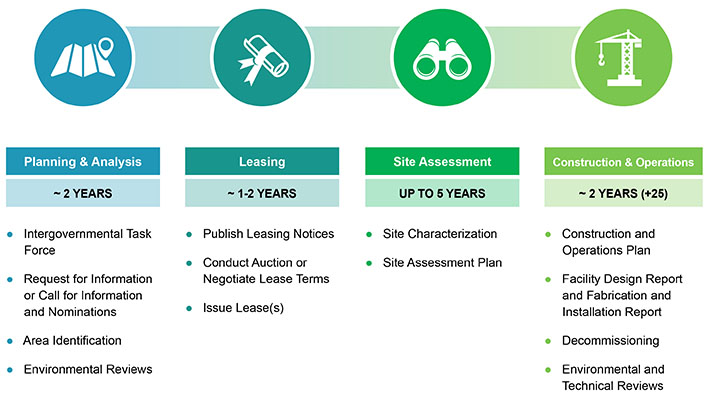
On April 24, 2024, Secretary of the Interior Deb Haaland announced that the Bureau of Ocean Energy Management (BOEM) and the Bureau of Safety and Environmental Enforcement (BSEE) had finalized updated regulations for renewable energy development on the U.S. Outer Continental Shelf (OCS).
Secretary Haaland also announced a new five-year offshore wind lease schedule, which includes up to 12 potential offshore wind energy lease sales through 2028.
Renewable Energy Modernization Proposed Rule
On Jan. 12, 2023, the Department of the Interior announced a proposed rule to update regulations for clean energy development on the U.S. for public review and comment. On Mar. 30, 2023, BOEM announced a 60-day comment period extension. Comments BOEM received can be found on regulations.gov by searching for Docket No. BOEM-2023-0005.
To submit a comment, go to regulations.gov and search for Docket No. BOEM-2023-0015.
BOEM-BSEE Renewable Energy Split Rule
On Jan. 17, 2023, the Department of the Interior announced that a final rule would publish that transfers regulatory oversight of certain renewable energy activities on the U.S. Outer Continental Shelf from BOEM to the Bureau of Safety and Environmental Enforcement (BSEE). The final notice was published in the Federal Register on Jan. 31, 2023.
Overview of BOEM's Regulatory Framework
The Energy Policy Act of 2005 (EPAct) authorized BOEM to issue leases, easements and rights of way to allow for renewable energy development on the Outer Continental Shelf (OCS). EPAct provided a general framework for BOEM to follow when authorizing these renewable energy activities. For example, EPAct requires that BOEM coordinate with relevant Federal agencies and affected state and local governments, obtain fair return for leases and grants issued, and ensure that renewable energy development takes place in a safe and environmentally responsible manner.
In 2009, the Department of the Interior announced the finalization of regulations governing BOEM's OCS Renewable Energy Program. These regulations provide a detailed structure to govern how BOEM manages its Renewable Energy Program, ensure that BOEM meets its statutory obligations, and provide both certainty and flexibility for overseeing the nascent offshore renewable energy industry. The updated regulations can be found here:
BOEM's renewable energy program occurs in four distinct phases: planning, leasing, site assessment, and construction and operations. BOEM engages key stakeholders throughout this process, as early communication with interested and potentially affected parties is critical to managing potential conflicts. BOEM's renewable energy regulations were updated in October 2011 to reflect the Bureau reorganization, and will be updated in the future to incorporate lessons learned and stakeholder feedback.
BOEM prepared a final Programmatic Environmental Impact Statement (PEIS) in support of establishing its program for authorizing renewable energy and alternate use activities on the OCS. The final PEIS examines the potential environmental effects of the program on the OCS and identifies policies and best management practices that may be adopted for the program. The Record of Decision for the PEIS can be found by clicking here.
On April 17, 2014, BOEM announced the publication of its Final Rule to extend timing requirements for submitting a Site Assessment Plan and a General Activities Plan pursuant to its renewable energy regulations. Click on the link below to access the Final Rule.
Workplace Safety for Outer Continental Shelf Renewable Energy Facilities
The Department of the Interior (DOI) announced steps to ensure workplace safety on Outer Continental Shelf (OCS) renewable energy facilities in the Federal Register on October 18, 2019. The new policy clarifies that DOI will act as the principal Federal agency for the regulation and enforcement of safety and health requirements for OCS renewable energy facilities.
DOI will continue to collaborate with the Occupational Safety and Health Administration (OSHA) and the U.S. Coast Guard to share relevant safety and training information and promote safety on the OCS.
For more information and guidance related to the workplace health or safety of employees on renewable energy facilities on the OCS, please visit the Bureau of Safety and Environmental Enforcement’s webpage at https://www.bsee.gov/what-we-do/renewable-energy.
Regulatory Roadmap
This "Regulatory Roadmap" provides guidance on the requirements for acquiring an offshore wind commercial lease on the Outer Continental Shelf (OCS), pursuant to 30 CFR 585. The Bureau of Ocean Energy Management (BOEM) is providing this document to clarify the steps and approvals necessary to develop an OCS wind facility.
This document is intended to be used as guidance to developers to outline the requirements of BOEM and other agencies that industry must follow when developing offshore wind projects. For public guidance outlining the process for overseeing renewable energy projects on the OCS and opportunities for public involvement, please see A Citizen's Guide.

National and Regional Guidelines for Renewable Energy Activities
BOEM has developed a number of national and regional guidelines for renewable energy activities on the Outer Continental Shelf (OCS). These informal documents are intended to provide lessees, operators and developers with additional information or interpretation of a regulation, OCS standard or regional requirement, clarification for implementation of a special lease stipulation or regional requirement, or updated administrative information (e.g., telephone listings, office address).
In addition, the Northeast Ocean Plan and Mid-Atlantic Regional Ocean Action Plan (the Plans) describe a series of collaborative actions and best practices related to the use of data, interjurisdictional coordination, and stakeholder engagement that will inform and guide Federal, State, Tribal, and Northeast and Mid-Atlantic Fishery Management Council activities under existing authorities. The Plans promote healthy ocean ecosystems and sustainable ocean uses. Consistent and within existing statutory authorities, BOEM will use the Plans to inform and guide its actions and decisions in the Northeast and Mid-Atlantic areas. The companion Northeast and Mid-Atlantic Ocean Data Portals (Data Portals) present thousands of publicly available maps that represent components of the marine ecosystem and a wide range of human activities. The Federal government has also placed authoritative geospatial information on the Marine Cadastre (https://marinecadastre.gov/) and analysis tools in OceanReports (https://www.marinecadastre.gov/oceanreports/). BOEM will consider data products available from these data portals in its decision-making, and encourages lessees and applicants to do so also.
Application and Leasing Guidance
Plan Submittals